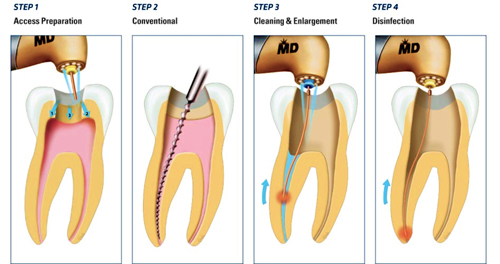
Root Canal Treatment (RCT)
Root Canal Treatment (RCT) are most commonly a painless procedure that will preserve your tooth and keep the structure from becoming damaged due to infection or trauma. In a nutshell, a root canal is actually your tooth saviour. The name Root Canal comes from the fact that the treatment is of the root part of the tooth, and more specifically, in the canal part of the root where the nerve, blood vessels, and connective tissue of the tooth reside.
To understand this endodontic treatment, it helps to know something about the anatomy of a tooth. Inside the tooth, under the white enamel and a hard layer called dentin, is a soft tissue called the pulp. The pulp contains blood vessels, nerves, and connective tissue and extends from the crown of the tooth to the tip of the roots where it connects to the tissues surrounding the root. This pulp is important during the tooth’s growth and development. In a fully developed tooth, it remains as a remnant of the soft tissue that initiated the tooth development.
Later in life, its only function is to cause pain when something goes wrong. Thus, it acts like an alarm system which may or may not work but is not necessary for the tooth. Thus, once the tooth is fully mature, it can survive without the pulp because the tooth continues to be nourished by the tissues surrounding it, viz. gums and the bone. And that is the fact and the principle on which the procedure and success of our treatment resides.

How is root canal treatment performed?
During RCT, local anesthesia is first given to numb the tooth and surrounding tissues to make it comfortable for the patient. The infected pulp tissue from inside the tooth is then removed and inside of the tooth is thoroughly cleaned to remove all the infection and dead tissue. This might require more than one appointments depending upon the amount of infection present. Upon complete sterilization of the canals, filling is done to restore the canal structure. Antibiotics may be prescribed to aid in the infection control and to speedup the recovery. A temporary filling is placed at the crown opening. Finally, during a subsequent appointment, a crown is installed to seal the tooth and protect it from further damage or infection.

ADDRESS 1
Abha Tooth World
Janta Colony,
Near Chandra Medicos,
Vaishali Nagar,
Ajmer- 305001(Rajasthan), India.
Phone No: +91-8003217749
Email ID: Mohit07oblivion@gmail.com
Address 2
Abha Tooth World
Near Murjani Medicos,
Panchsheel B Block,
Panchsheel,
Ajmer - 305001(Rajasthan), India.
Phone No: +91-8003217749
EmailID:Mohit07oblivion@gmail.com
